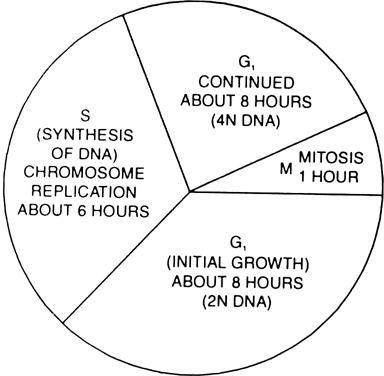1. Prophase II. It occurs immediately after cytokinesis of meiosis I. The nuclear membrane disaapars and chromosomes become compact.
2. Metaphase II. The chromosomes arrange themselves on the equator. Each chromosome is attached to the spindle fibres of opposite poles by its centromeres. The spindle microtubules from the opposite poles attach to the kinetochores of sister chromatids.
3. Anaphase II. The centromere of each chromosome divides into two sister chromatids. Thus two chromatids of each chromosome move towards opposite poles.
4. Telophase II. The group of young chromosomes at each pole arranges itself into a daughter nucleus. The nuclear membrane is formed. Nucleoli appear and spindles disappear. takes place resulting in the formation of four daughter cells.
1. First gap phase (G1 phase) or presynthetic phase.
2. Synthetic phase (S phase)
3. Second gap phase (G2 phase) or Mitotic phase (M phase)
4. Cell division phase or Mitotic phase (M phase).
The G1, S and G2 phases together constitute the Interphase. This phase takes about 95% of the duration of cell cycle. The mitotic or M phase only lasts for about an hour.
1. G1 phase. This stage starts from the birth of the daughter cell and ends upto the time when the cell begins to synthesis of DNA. It is the phase of initial growth in which RNA and proteins are synthesised. Its duration varies from 6 to 8 hours.
2. S phase. It is the period of synthesis of DNA. It lasts for 5-6 hours.

Fig. Cell cycle
3. G2 phase. During this phase the centrioles, mitochondria, golgi bodies and other cytoplasmic organelles are doubled. Proteins are synthesised for the formation of astral rays and spindle and energy is stored for the cell division or M phase. The duration of this stage starts from the end of S phase upto the beginning of M phase. It lasts for 4-8 hours.
4. M phase or mitosis. It is the phase when the cell division takes place and this process gives rise to two daughter cells. collectively form the cell cycle.
1. It is an equational division. The daughter cells are identical to each other and also to the parent cell in genetic constitution.
2. Mitosis helps in the survival of a species and continuation of its race. It gives a complete set of genetic information to each cell.
3. Mitosis is related to the growth of an individual from zygote to adult stage.
4. It helps in repairing of cells, healing of wounds and regeneration of body cells.
5. It helps in maintaining a specific nucleocytoplasmic ratio in a cell.
2. Formation of spores. Meiosis produces spores in plants for asexual reproduction.
3. Maintenance of chromosome number. Meiosis reduces the chromosome number in the gametes so that fertilization may restore the original diploid number in the zygote.
4. Introduction of variations. Meiosis provides a chance for the formation of new combinations of alleles and chromosomes. This brings about variations which cause evolution. The new combinations of alleles are produced by crossing-over in prophase-I.
